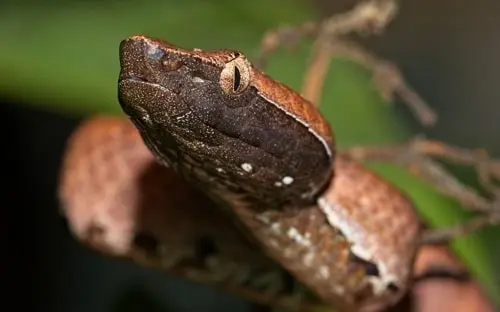Snakes, the name that we all fear of. Although there are only a few species that are dangerous to humans, still, the snakes are considered as the deadliest creatures for the mankind. Talking specifically about India, there are over 250 species of snakes, out of which 50 species can be treated as a threat to humans. With such a huge variety,it is essential to know which of these are poisonous and which of them are harmless.
In this article, we will talk about the ten most common snakes we may encounter at hour homes and at workplaces. Also, we will let you know about which of these ten are poisonous and which of them can easily be tackled with calmness. So, without wasting more time, let’s jump straight to the list of the ten most common snakes found in India.
List of Top Snakes Found in India
10. Yellow-Lipped Sea Krait
Yellow-lipped sea krait may look beautiful, but believe us, this is one of the deadliest snakes found in the Indian sea region. Although it spends most of its time in the water, it often comes to land for the fresh water.
Often mistaken as an eel, this snake is extremely venomous. This snake is often found in the land near the Indo-pacific sea region, where it usually spotted near the shores in search of fresh water. Make sure to not to get disguised by its beauty and stay away from the place it is spotted.
The venom of Yellow-lipped sea krait contains α-neurotoxin that causes laziness, paralysis, extreme shivering and even death in some cases.
9. Malabar Pit Viper
Malabar pit viper is a common snake which is found in the south and west region of India. Also, these snakes can be found in the forests of the Western Ghats and West Coast. Apart from being a common snake in India, this isamongst the top six deadliest snakes found in India. These snakes can be commonly encountered in the monsoon seasons near the rainforests and villages with the damp atmosphere.
8. Albino Russell’s viper
Albino Russell’s viper is one of the most common vipers in India. You can spot them anywhere in the Southern, Western or eastern region of India. They commonly feed on the lizards, and birds but have deadly venom which is enough to make a human critical. The intensity of venom is not on par with the other deadly snakes, and that’s the reason why the Albino Russell’s Viper relies on the amount of venom it transfers to the victim’s body in one bite. Albino Russell transfer a large amount of its venom with a single bite. The venom of snake attacks the neural system of the victim and can severely damage it if the victim can’t reach the medical help within a few hours of the bite.
7. Saw-scaled Viper
Another common viper you can find in India is the Saw-scaled viper. Commonly known as carpet viper or Echis, these are slow movers but are tremendously venomous snakes found in India. Apart from India, the saw-scaled vipers are commonly found in Pakistan, Sri Lanka,and Africa.
Talking about their physical appearance, they are relatively smaller than the other viper snakes. You can distinguish them by the sound they make through the scales. The common diet of the saw-scaled viper include rats, lizards, and small birds.
6. Indian Pit Viper
Indian Pit Viper, or more commonly known as a Bamboo snake or tree viper are commonly found in the bushes and vines. The bright green colored skin helps it to camouflage and makes it easier to hunt for the birds. The pit viper’s geographical presence is limited to the southern parts of India. This snake prefers to live in the greener forests near the streams where it can easily get the good supply of food.
The pit viper’s venom has Haemotoxic which affects the red blood cells of the victim’s body and disrupts blood clotting. In severe cases, the pit viper’s venom can cause organ failure.
5. Indian Krait
Usually found inactive in the daytime, the Indian Krait is a highly poisonous snake that commonly hunts in the night. Indian Krait has a wide range of possible habitats including the low scrub jungle and the farm-houses where it can possibly find the common snake diet like rats, small birds, frogs,and lizards.
The Indian Krait in one of the deadliest snakes found in India, and this is the reason why it is included in the big fours (most venomous snakes of India). Bright blue scales makes it easy to recognize and it is highly recommended that you should keep a safe distance especially in the nights.
The venom of India Krait has deadly neurotoxins that can cause muscle paralysis. The worst part of the Indian Krait bite is the victim feels minor or no pain when the snake bites. This makes it even more dangerous as the victim may ignore the bite that can severely damage the neural network.
4. King Cobra
We all are well aware of the great King Cobra. Apart from being the deadliest, this snake is also amongst the biggest venomous snakes of the world. At max, they can grow up to 18 ft, and the average size of an adult king cobra ranges 12 to 14ft. Apart from the common snake diet, the king cobra has some other snakes too on its diet.
Unlike the Indian Krait and other venomous snakes found in the Indian subcontinent, the king cobra remains active in the daylight as well in the night. When the snake feels any threat, it can easily lift one-third of its body and makes a loud hissing sound that makes it look even more dangerous.
The venom of the King cobra mainly consists of Haditoxin which directly attacks the central nervous system of the human body. The venom of King cobra is deadly enough to kill a human within an hour. This is another snake that is listed as the four most venomous snakes of India.
3. Spectacled Cobra
When it comes to the most snakebites in India, the main culprit that can be blamed for it is the Spectacled Cobra. Spectacled Cobra or Naja Naja and can be often seen with the snake charmers in India. As per the behavior, this can be treated as the most active snake that is ready to bite the attacker in any case. The spectacled cobra is relatively smaller than the king cobra but its aggressive nature makes it even more dangerous than most of the other four deadliest snakes in India. Unlike the King cobra, the venom of the Spectacled cobra contains a post-synaptic neurotoxin that attacks synaptic gaps of the nerves. This results in muscle paralysis and in severe cases result in death.
2. Indian Rock Python
Indian rock python is another common snake that is considered as deadly due to size and the common perception of humans about the huge snakes. But believe us, this snake has no poison. Yes, you heard it right. The snake may look terrifying due to its appearance, but if it bites you it is nothing to worry and you can consult a doctor for some simple medicines.
Commonly known as Ajgar in India, it has dark brown patterns on its body and has a narrow head that makes it easily recognizable. Even though the snake has no venom, but can bite with its razor-sharp teeth. The snake heavily relies on the mammals for its diet and swallows them as a whole.
1. Hump Nosed Pit Viper

The Hump-nosed pit viper is the most common snake you can find in India. These snakes have an unusual kind of nose that distinguishes them from the other snakes of its family. Other differences between the Hump-nosed pit viper and other vipers include smooth scales of the body and a thin triangular head. They are usually found in the dense forests of northern India and generally hunt in the night.
The venom of the Hump Nosed Pit viper has Haemotoxic that reacts with the red blood cells and prevents the clotting that eventually affects the victim with severe blood loss.
The color and pattern on the body make it almost invisible in the wild and thus it is one of the best-hunting snakes in the forests and natural habitats.
So, these were the most common snakes that we can find in India. One thing that you should keep in mind when you encounter any snake of the above list, is that you should never provoke him to attack. If possible, evacuate the place and call for help. Snakes usually don’t attack humans until they feel the danger. Snakes can be too quick to your perception and even if they are not poisonous, it is not a good idea to get closer to them.
Out of these ten, four (commonly known as the big four) snakes are extremely venomous and it is advised that if you find them anywhere, you should evacuate the place and call the snake experts immediately.
Santosh Kumar, the author behind IndiasStuffs.com, is passionate about sharing valuable insights on a variety of topics, including lifestyle, technology, and Indian culture.
Page Contents

